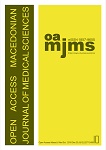Impact of Lower-Limb Endurance Training on Dyspnea and Lung Functions in Patients with COPD
DOI:
https://doi.org/10.3889/oamjms.2018.381Keywords:
COPD, Dyspnea, Pulmonary function, Lower-limb endurance trainingAbstract
BACKGROUND: Patients with chronic obstructive pulmonary disease (COPD) exhibit persistent dyspnea in daily activities and irreversible airflow obstruction. These will finally lead to an inability to carry on daily activities and markedly decrease their quality of life. Endurance training was considered as therapy modality to alleviate several symptoms experienced by COPD patients.
AIM: This study aims to identify the impact of lower-limb exercise on dyspnea and spirometry test results in COPD patients.
METHODS: We performed a quasi-experimental study in July 2017 on 20 stable COPD patients divided both in group C and D according to GOLD 2017 criteria. Patients were given an individualised dose of stationary cycling twice a week for one month in which every session lasted 5-20 minutes gradually. Before and after rehabilitation program, pulmonary function tests were measured by spirometry to obtain per cent predicted of Forced Expiratory Volume in 1 second (FEV1), Forced Volume Capacity (FVC), Peak Expiratory Flow (PEF) and Forced Expiratory Flow at 25-75% of the pulmonary volume (FEF25-75), and dyspnea was measured by the mMRC index. Statistical analysis was performed by Wilcoxon and T-dependent test.
RESULTS: Baseline value of FVC (49.6 ± 21.6%) increased significantly to 59.65 ± 16.53% after one month of endurance training program (p = 0.01). Surprisingly, there was also a significant increase in FEV1 value from 46.9 ± 21.7 to 52.9 ± 20.7% (p < 0.005). The increase of FVC and FEV1 in group C was slightly higher than in group D although not statistically significant (p = 0.29; p = 0.25 respectively). However, no difference was observed in PEF and FEF25-75 value (p > 0.05). Patients’ dyspnea scale also showed significant improvement (p < 0.001) from mMRC median scale 2 (range 1-3) to 1 (range 0-2) in both groups C and D. There was no exacerbation found during rehabilitation program.
CONCLUSION: Twice a week lower-limb endurance training for one-month improved dyspnea and pulmonary function test results in COPD patients safely and effectively.
Downloads
Metrics
Plum Analytics Artifact Widget Block
References
Vogelmeier CF, Criner GJ, Martinez FJ, Anzueto A, Barnes PJ, Bourbeau J, Celli BR, Chen R, Decramer M, Fabbri LM, Frith P. Global strategy for the diagnosis, management, and prevention of chronic obstructive lung disease 2017 report. GOLD executive summary. American journal of respiratory and critical care medicine. 2017; 195(5):557-82. https://doi.org/10.1164/rccm.201701-0218PP PMid:28128970
Stendardi L, Binazzi B, Scano G. Exercise dyspnea in patients with COPD. International journal of chronic obstructive pulmonary disease. 2007; 2(4):429. PMid:18268917 PMCid:PMC2699965
Hodonská J, Neumannová K, Svoboda Z, Sedlák V, Zatloukal J, Plutinský M, KoblÞek V, Bizovská L. Incremental shuttle walk test as an indicator of decreased exercise tolerance in patients with chronic obstructive pulmonary disease. Acta Gymnica. 2016; 46(3):117-21. https://doi.org/10.5507/ag.2016.012
Walker PP, Burnett A, Flavahan PW, Calverley PM. Lower limb activity and its determinants in chronic obstructive pulmonary disease. Thorax. 2008. https://doi.org/10.1136/thx.2007.087130 PMCid:PMC2717793
Nyberg A, Carvalho J, Bui KL, Saey D, Maltais F. Adaptations in limb muscle function following pulmonary rehabilitation in patients with COPD–a review. Revista Portuguesa de Pneumologia (English Edition). 2016; 22(6):342-50. https://doi.org/10.1016/j.rppnen.2016.06.007 PMid:27522458
Bernard S, Ribeiro F, Maltais F, Saey D. Prescribing exercise training in pulmonary rehabilitation: A clinical experience. Revista Portuguesa de Pneumologia (English Edition). 2014; 20(2):92-100. https://doi.org/10.1016/j.rppnen.2014.03.005
Castagna O, Boussuges A, Vallier JM, Prefaut C, Brisswalter J. Is impairment similar between arm and leg cranking exercise in COPD patients?. Respiratory medicine. 2007; 101(3):547-53. https://doi.org/10.1016/j.rmed.2006.06.019 PMid:16890417
Nusdwinuringtyas N, Widjajalaksmi W, Bachtiar A. Healthy adults maximum oxygen uptake prediction from a six-minute walking test. Medical Journal of Indonesia. 2011; 20(3):195-200. https://doi.org/10.13181/mji.v20i3.452
Riskesdas Riset Kesehatan Dasar. Badan Penelitian Dan Pengembangan Kesehatan RI, 2013.
Koniski ML, Salhi H, Lahlou A, Rashid N, El Hasnaoui A. Distribution of body mass index among subjects with COPD in the Middle East and North Africa region: data from the BREATHE study. International journal of chronic obstructive pulmonary disease. 2015; 10:1685. PMid:26346564 PMCid:PMC4554407
Tarigan AP. Hubungan Polimorfisme Gen TNFα Pada Posisi -308 Dan -238 Dengan Kejadian Penyakit Paru Obstruktif Kronik. Universitas Sumatera Utara, 2013. Retrieved from http://repository.usu.ac.id/handle/ 123456789/35075
PDPI. PPOK: Diagnosis dan Penatalaksanaan. Jakarta: UI Press, 2016.
Casaburi R. Exercise training in chronic obstructive lung disease. Principles and practice of pulmonary rehabilitation. 1995:204-24.
França DC, Vieira DS, Vieira BD, Britto RR, Parreira VF. Lower-limb endurance training program influences thoracoabdominal motion of patients with COPD?. Fisioterapia em Movimento. 2013; 26(1):141-50. https://doi.org/10.1590/S0103-51502013000100016
Stendardi L, Binazzi B, Scano G. Exercise dyspnea in patients with COPD. International journal of chronic obstructive pulmonary disease. 2007; 2(4):429. PMid:18268917 PMCid:PMC2699965
Downloads
Published
How to Cite
Issue
Section
License
Copyright (c) 2018 Amira Permatasari Tarigan, Pandiaman Pandia, Erna Mutiara, Andika Pradana, Ella Rhinsilva, Efriyandi Efriyandi

This work is licensed under a Creative Commons Attribution-NonCommercial 4.0 International License.
http://creativecommons.org/licenses/by-nc/4.0







